Physical Address
304 North Cardinal St.
Dorchester Center, MA 02124
The effects of occlusion of hepatic artery branches are unpredictable because of the liver’s double blood supply and variable collateral flow. Potential effects of thrombotic or other occlusion include infarction and ischaemic damage to the biliary tree leading to stricture formation, cholangitis or duct rupture. The branches of the hepatic artery are sometimes involved in polyarteritis nodosa ( Fig. 12.1 ), the arteritis of systemic lupus erythematosus , Schönlein–Henoch purpura and giant-cell arteritis . In the last, the liver may contain granulomas of classical or fibrin-ring type. The arterial lesions of these systemic diseases are not often seen in needle biopsies of the liver. Vasculitis affecting small intrahepatic vessels is sometimes a manifestation of infection or neoplasia.

In some older patients, especially those with systemic hypertension, small arteries and arterioles in portal tracts appear thickened and hyaline. Patients with diabetes and hypertension may show an arteriolar microangiopathy, hyaline arteriolosclerosis , with increased wall thickness and deposition of periodic acid–Schiff (PAS)-positive material within the vessel wall. Amyloidosis can give rise to thickening of arterial walls in the absence of sinusoidal deposits.
The arteriovenous malformations and telangiectases of hereditary haemorrhagic telangiectasia are sometimes found in the liver, with or without surrounding fibrosis. The presentation is as portal hypertension (accompanied by hepatic encephalopathy and nodular regeneration ), biliary disease (sometimes resembling primary sclerosing cholangitis or Caroli’s disease) or cardiac failure due to arteriovenous shunting. Patients with liver involvement may have raised serum alkaline phosphatase levels without jaundice (anicteric cholestasis), attributed to abnormal blood supply to the biliary tree. Severely damaged medium-sized bile ducts are occasionally seen histologically.
Infarcts of the liver result from arteritis, aneurysms, thrombosis, embolism or surgical ligation. They may complicate pregnancy or liver transplantation. Infarction can also follow occlusion of portal-vein branches, and may even be found in the absence of demonstrable vascular obstruction. The pathological features are as in other organs: there are well-defined zones of coagulative necrosis with congested and inflamed borders ( Fig. 12.2 ). Portal tracts may survive within the infarcted areas. Coagulative necrosis of the centres of cirrhotic nodules following hypoperfusion is sometimes called nodular infarction.
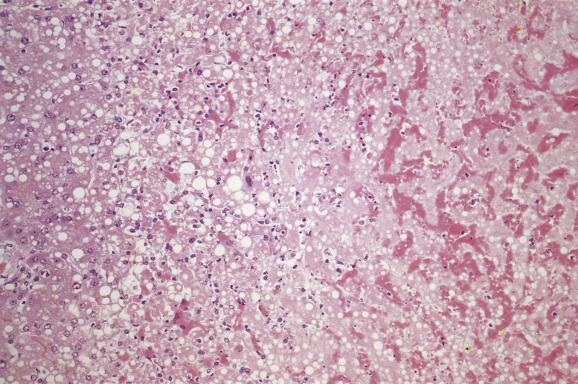
Severe hypoperfusion of the hepatic parenchyma leads to necrosis, usually in perivenular regions (acinar zone 3) but also, additionally or alternatively, in mid-zonal regions (zone 2). Portal tracts and the periportal parenchyma typically remain normal. However, there are uncommon instances where interlobular bile ducts are injured due to hepatic hypoperfusion, especially in severely ill individuals with prolonged intensive care hospitalisations, and changes similar to sclerosing cholangitis may develop. In contrast to the necrosis of acute hepatitis there is usually little or no inflammation, but in some patients neutrophils accumulate in limited numbers, particularly if the individual has received pressor support for 1 day or more. Affected areas may be congested, and contain large, ceroid-laden macrophages. There may be cholestasis and evidence of regenerative hyperplasia in the surviving parenchyma. The reticulin network shows regular condensation in the necrotic areas. Similar changes are seen in patients with heatstroke ( Fig. 12.3 ). There may be steatosis in the surviving parenchyma. Inflammation ranges from absent in mild cases to severe when the damage is extensive. Systemic candidiasis is a complication.
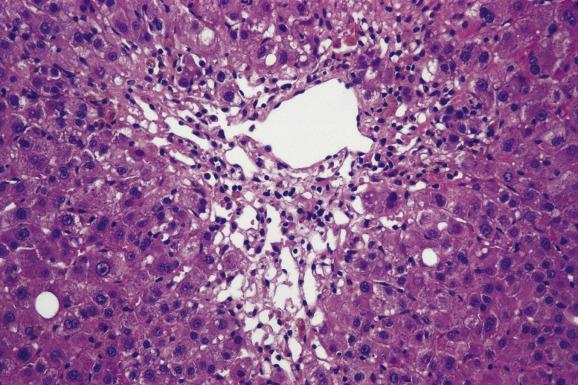
One of the most important causes of this type of necrosis is heart failure with consequent hypoperfusion of the liver. The term ischaemic hepatitis is commonly used for the viral hepatitis-like clinical picture which may ensue. Congestive heart failure leads to sinusoidal dilatation (see the ‘Venous congestion and outflow obstruction’ section).
Thrombosis of the main portal veins may result from infection (local or in the portal venous drainage area), cirrhosis, liver transplantation, disorders of coagulation and venous outflow obstruction. Invasion by hepatocellular carcinoma is a common cause. In some patients no reason for the thrombosis can be discovered, but an underlying thrombophilic condition should always be excluded. In the acute phase of pylephlebitis, septic thrombi may be seen in portal-vein branches in portal tracts ( Fig. 12.4 ).
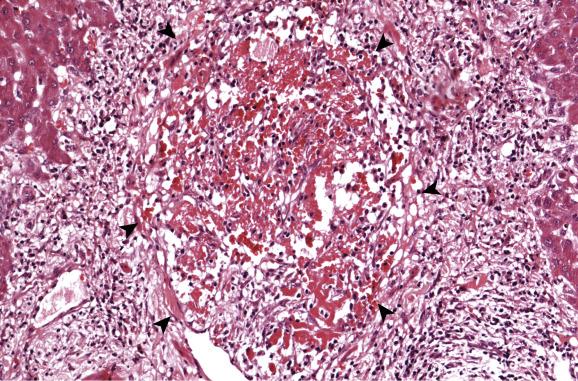
Possible results of portal-vein thrombosis include diffuse or focal parenchymal atrophy, increase in the number of apoptotic hepatocytes, parenchymal nodularity (see the ‘Nodular regenerative hyperplasia’ section in Ch. 11 ) and a mild deg ree of portal fibrosis. Focal atrophy, also known as Zahn’s infarction, is often found at the margins of tumour nodules. Occasionally, portal venous obstruction leads to true infarction of the hepatic parenchyma. In many patients with thrombosis of the main portal veins the liver remains histologically normal.
Portal-vein branches are absent from portal tracts in the rare Abernethy malformation (congenital extrahepatic portosystemic shunts). In this condition the extrahepatic portal vein is either absent or severely atrophic, and portal blood is diverted to the inferior vena cava, rather than returning to the heart via the liver. Intrahepatic small portal tracts show absent veins, fibrous vein remnants, dilated lymphatics and arteriolar changes ( Fig. 12.5 ). Various nodular lesions including focal nodular hyperplasia, hepatocellular adenoma and hepatocellular carcinoma (with beta-catenin mutations) may develop.
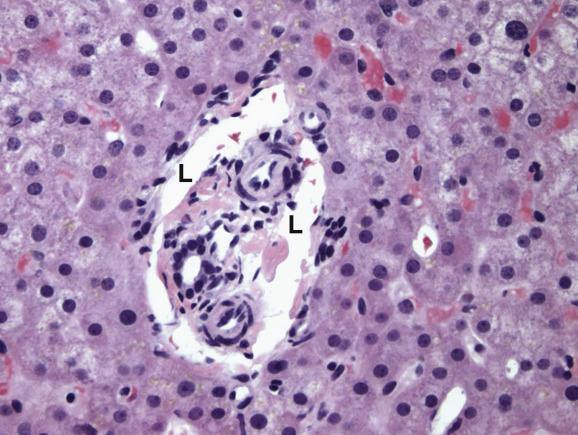
Portal hypertension is most often the result of cirrhosis. Other causes include schistosomiasis, alcohol-related liver disease, non-alcoholic steatohepatitis, congenital hepatic fibrosis, the tropical splenomegaly syndrome, hepatic venous outflow obstruction and portal venous thrombosis. The last probably contributes to portal hypertension in polycythaemia and other haematological diseases. In lymphoproliferative and myeloproliferative disorders, the portal infiltration may be a further pathogenetic factor. The anatomical subdivision of portal hypertension into prehepatic, intrahepatic and posthepatic forms should be considered in conjunction with specific structural alterations in classifying the individual case.
There remains a somewhat ill-defined group of patients with portal hypertension not attributable to cirrhosis or to the other causes mentioned earlier ( non-cirrhotic portal hypertension ). These cases represent an intrahepatic type of portal hypertension which is a category separate from prehepatic causes such as thrombosis of the major portal vein and from posthepatic causes such as congenital webs of the inferior vena cava. Several different labels have been used to describe aspects of this group (hepatoportal sclerosis, non-cirrhotic portal fibrosis, idiopathic portal hypertension) . The term obliterative portal venopathy has also been used and indicates that there may be demonstrable thrombosis or narrowing of portal-vein branches, but this is not always the case, and it is not clear whether the portal venous narrowing or occlusion is primary or secondary. Non-cirrhotic portal hypertension is most prevalent in India and Japan, but is also described in Western countries. Certain cases have been attributed to a toxin or toxins such as arsenic, vinyl chloride, azathioprine, cytotoxic drugs and didanosine therapy in human immunodeficiency virus (HIV) disease. Thrombophilic/pro-coagulant states need to be excluded as possible causes. In many patients no cause is found. Variceal bleeding and portal-vein thrombosis are important long-term complications.
Needle liver biopsies from patients with non-cirrhotic portal hypertension are often normal or show only non-specific changes. Abnormalities are more likely to be seen in operative wedge biopsies. Portal-vein branches are sometimes thickened and narrowed, unusually inconspicuous or replaced by multiple small, thin-walled channels. Their overall area is reduced, while portal tract lymphatics increase in number. Dilated venules appear to herniate into the adjacent parenchyma ( Fig. 12.6 ). There may be portal fibrosis and enlargement, with or without inflammatory-cell infiltration ( Fig. 12.7 ). Slender fibrous septa extending from the portal tracts give an appearance indistinguishable from incomplete septal cirrhosis. These septa sometimes connect with bridge-like zones of necrosis. There may be randomly distributed thin-walled vessels in the lobules (megasinusoids), and sclerosis or dilatation of efferent veins.
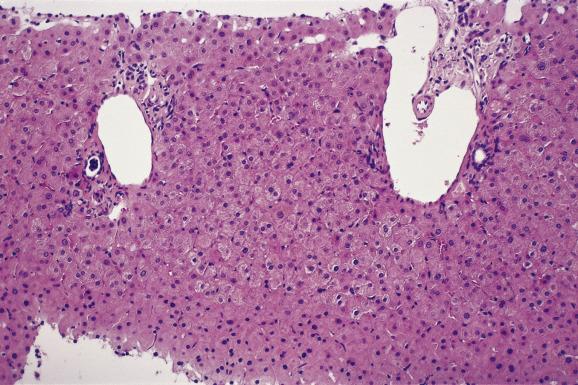
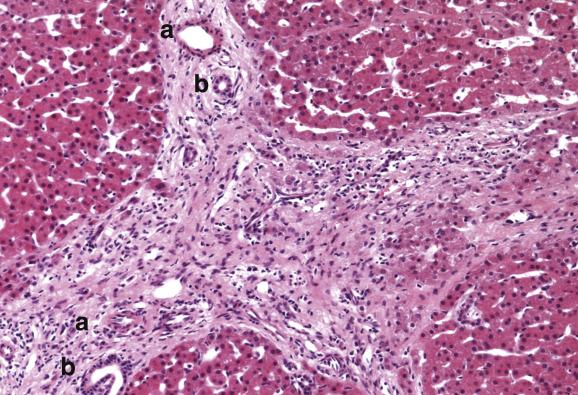
Diffuse or localised nodular hyperplasia of the parenchyma is commonly seen in these patients. There is thus overlap between hepatoportal sclerosis, nodular regenerative hyperplasia, incomplete septal cirrhosis and, rarely, partial nodular transformation. Nodular regenerative hyperplasia, however, is also found in the absence of clinically evident portal hypertension.
In patients exposed to vinyl chloride monomer and other carcinogens there may be, in addition to the aforementioned features, perisinusoidal fibrosis and an increase in the number and size of sinusoidal cells. Perisinusoidal fibrosis may also contribute to the portal hypertension which develops in some patients after renal transplantation. Prolonged drug therapy has been suggested as a possible mechanism.
Become a Clinical Tree membership for Full access and enjoy Unlimited articles
If you are a member. Log in here